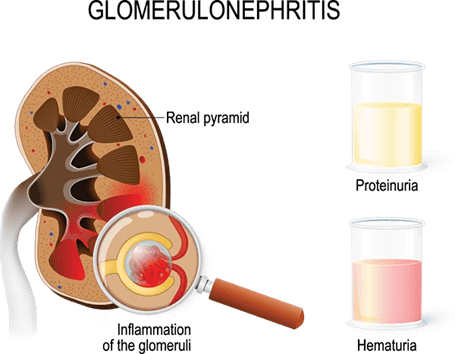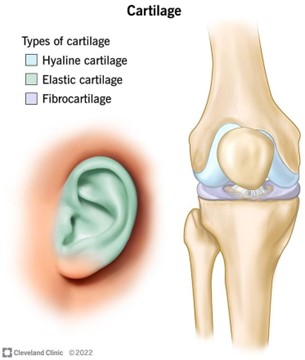A nurse is collecting data from a child who has acute glomerulonephritis.
Which of the following findings should the nurse expect?
Decreased blood pressure
Pale yellow urine
Periorbital edema
Increased urination
The Correct Answer is C
c. Periorbital edema.
Explanation: Acute glomerulonephritis is an inflammatory condition affecting the glomeruli of the kidneys. It is commonly characterized by periorbital edema, which is swelling around the eyes. This occurs due to fluid retention and impaired kidney function. Other common manifestations of acute glomerulonephritis include hypertension (increased blood pressure), dark or tea-colored urine (hematuria), decreased urine output, and signs of fluid overload such as edema in the hands, feet, and face.
Option a, decreased blood pressure, is not typically seen in acute glomerulonephritis. Instead, hypertension is a common finding due to fluid retention and increased blood volume.
Option b, pale yellow urine, is not expected in acute glomerulonephritis. Instead, urine may appear dark or
tea-colored due to the presence of blood (hematuria).
Option d, increased urination, is not a characteristic finding in acute glomerulonephritis. Instead, there is often a decrease in urine output or oliguria.
It is important to note that individual presentations may vary, and the nurse should consider the complete clinical picture and the child's specific symptoms when assessing for acute glomerulonephritis.

Nursing Test Bank
Naxlex Comprehensive Predictor Exams
Related Questions
Correct Answer is {"dropdown-group-1":"A","dropdown-group-2":"C"}
Explanation
Compartment syndrome occurs when there is increased pressure within a closed muscle compartment, leading to reduced blood flow to the muscles and nerves in that compartment. In this case, the open fracture and subsequent reduction and stabilization procedure can cause swelling and increased pressure within the affected compartment. This can impede blood flow and potentially lead to tissue damage. Common symptoms include severe pain, swelling, numbness, and decreased or absent pulses. Immediate medical attention is necessary if compartment syndrome is suspected.
Deep Vein Thrombosis (DVT) refers to the formation of blood clots within the deep veins, typically in the lower extremities. In the case of a client with an open fracture and immobilization with a splint, the risk of DVT increases due to factors such as reduced mobility, injury to blood vessels, and blood stasis. DVT can lead to serious complications if a clot dislodges and travels to the lungs, causing a pulmonary embolism. Symptoms of DVT may include pain, swelling, warmth, and redness in the affected limb.
While osteomyelitis and fat embolism syndrome can occur as complications of long bone fractures, they are not explicitly mentioned in the given scenario. Osteomyelitis refers to an infection in the bone, which can develop if bacteria enter an open fracture. Fat embolism syndrome can occur when fat globules from the bone marrow enter the bloodstream, usually following a long bone fracture.

Correct Answer is D
Explanation
d. Increased joint stiffness due to loss of elasticity in joint cartilage.
Explanation:
The correct answer is d. Increased joint stiffness due to loss of elasticity in joint cartilage.
When teaching an older adult client about age-related changes, it is important for the nurse to provide accurate and relevant information. Joint stiffness is a commonly experienced age-related change that occurs due to the natural loss of elasticity in joint cartilage. As people age, their joints may become stiffer and less flexible, making movements and activities more challenging.
Option a is not the correct answer. Increased nail growth due to the buildup of calcium deposits is not an expected age-related change. Nail growth is primarily determined by factors such as genetics, overall health, and nutritional status, rather than calcium deposits.
Option b is not the correct answer. Increased perspiration due to overproduction by the sweat glands is not an expected age-related change. In fact, older adults may experience a decrease in the production of sweat, which can make them more susceptible to heat-related illnesses and dehydration.
Option c is not the correct answer. Increased cardiac output due to weakened heart walls is not an expected age-related change. With aging, the heart muscles may become stiffer and less efficient, leading to a decrease in cardiac output rather than an increase.
By focusing on the expected age-related change of increased joint stiffness due to loss of elasticity in joint cartilage, the nurse can provide accurate information and help the older adult client understand and manage this common aspect of the aging process.

Whether you are a student looking to ace your exams or a practicing nurse seeking to enhance your expertise , our nursing education contents will empower you with the confidence and competence to make a difference in the lives of patients and become a respected leader in the healthcare field.
Visit Naxlex, invest in your future and unlock endless possibilities with our unparalleled nursing education contents today
Report Wrong Answer on the Current Question
Do you disagree with the answer? If yes, what is your expected answer? Explain.
Kindly be descriptive with the issue you are facing.
